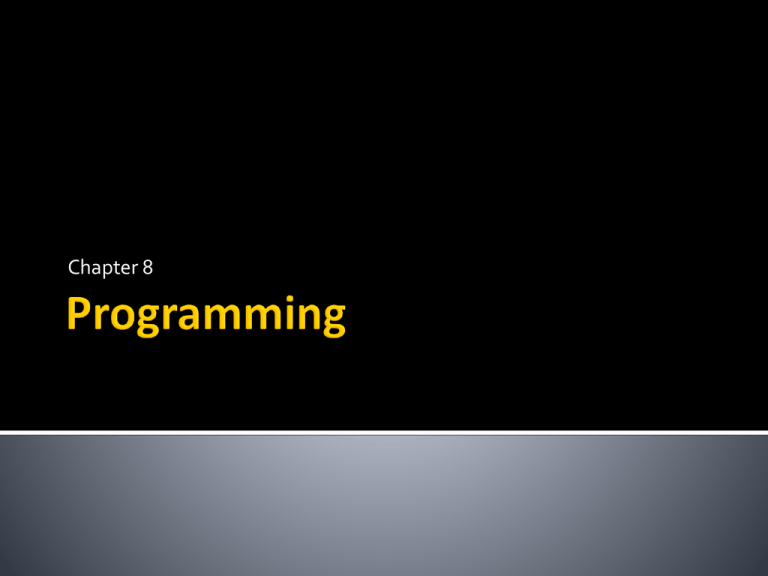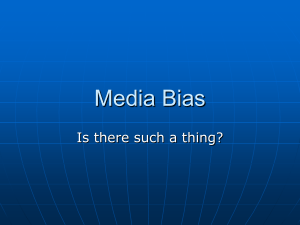Programming - Professor Leach
advertisement

Chapter 8 Self Produced ▪ When programming is produced by the organization distributing it. ▪ HBO filming it’s own movies ▪ ESPN covering games it broadcasts Related & Non-related media ▪ When media is shared between departments ▪ NBC taking subsidiary hit program ▪ Puts it on main network ▪ GE owned company sharing with other GE owned company ▪ NBC CNBC MSNBC Voice Tracking ▪ Radio announcers intro’s & outro’s for many of the companies stations Affiliate ▪ Stations associated with a network ▪ Programming content provided by the network Non-Related ▪ When companies not related through parent ▪ Share programming with each other Majors & Independents Programmers also get material from ▪ Major production companies ▪ (ones that also make movies) Time Windows ▪ The time from theatrical release to showing elsewhere Independents ▪ Private production companies paid to develop shows/content Syndicators ▪ Buy old popular “Off-Net” programs ▪ Present them to target audience Not as effective today because of DVD’s of network shows New TV programs, series & movies ▪ Go through development phase ▪ They start with an idea As idea is expanded a PITCH is developed ▪ Presented to network executives Accepted pitches lead to a PILOT ▪ Single show as it would be aired on TV Other Challenges Executive Decisions ▪ May want demographic changes ▪ Age of lead ▪ Location ▪ To go with SEQUEL to popular movie ▪ SPIN-OFF TV show ▪ Involves characters from popular series Different than other programs & series ▪ Content controlled by gatekeepers ▪ Decisions are made quickly News Gathering ▪ Staff identifying & covering important stories ▪ Assignment editor ▪ Embedded ▪ Stringers ▪ Scanners ▪ Devices used to monitor police & fire radios News Agencies/Wire services ▪ Stories, Sound bites, Video Public Contributions ▪ Calling in tips/leads ▪ Sending in video ▪ Phones, camcorders, etc ▪ Blogs Presentation ▪ Television, online Radio CLOCK - used to determine specific content ▪ Traffic on the 1’s – What does this mean? Dayparts ▪ ▪ ▪ ▪ ▪ Morning drive (6-10 am), Midday (10 am-3 pm), Afternoon drive (3-7 pm), Evenings (7 pm-12 midnight), Overnight (midnight-6 am Movies Many movies ▪ Especially high budget ones ▪ Typically released during summer & holidays ▪ WHY? Scheduling Factors DVR’s & DVD’s ▪ Allow rearranging of original program schedule Prime Time ▪ Most important block in Television ▪ WHY Changes in shows ▪ Cancellations ▪ Moves to new times Scheduling Strategies Block programming ▪ Same type of shows shown all evening ▪ (sitcoms, drama, etc) Hammocking ▪ New series between two strong one Tentpoling ▪ New/Weak series before and after a strong one Stripping ▪ Same show, same time, every day Several forms of drama ▪ Soap Operas ▪ Serialized to entice viewer to “tune in tomorrow” ▪ Anthology dramas ▪ Individual stories ▪ Different characters in each (episode) ▪ Episodic serialized dramas ▪ Set characters ▪ Episodes cover complete storylines ▪ Miniseries & Docudramas Mainstay of media ▪ Sitcoms ▪ Primary form of comedy ▪ Started on radio, migrated to TV ▪ Other forms ▪ SNL, skits ▪ Variety shows ▪ Stand up comedy Comedy has been threatened by ▪ Reality TV Started in the 50’s ▪ (candid camera) Popularized in the 1990’s ▪ Initially thought to be short lived ▪ Low cost appealed to networks ▪ Human element appealed to viewers ▪ CBS show Survivor (2000) ▪ Solidified genre as appealing to audience Term extended to other forms ▪ American Idol, Who wants to be a millionaire Longtime popular format ▪ Started in radio ▪ Migrated to TV Quiz show scandals (1958) ▪ Dealt temporary blow to genre Eventually new shows helped re-establish genre ▪ Jeopardy ▪ Wheel of Fortune ▪ What are some other? American Bandstand ▪ First hit music program on TV 1981 MTV introduced music video format ▪ Most successful TV music concept Music video popularity ▪ Led to placement elsewhere ▪ Commercials networks ▪ Local stations ▪ Cable stations Criticized for possible negative impact on youth Gatekeepers ▪ Those in position to determine what information is presented Variety ▪ More and more news stations ▪ Offer content to match numerous views ▪ Liberal, conservative, etc Politics ▪ News delivers much political information ▪ Can influence perceptions & outcomes Criticisms ▪ ▪ ▪ ▪ Lack of depth Tasteless coverage of victims Over coverage of tiresome stories Subjectivity/Bias Radio Talk Shows Started as in studio interviews Today, telephones allow call in’s ▪ Enhancing radio talk shows ▪ Involve in studio & audience TV talk shows ▪ 1947 Meet the press (Earliest TV talk show) ▪ Interviews with political and social figures Morning Talk Shows (Like Today show) ▪ Interviews news, features, weather, etc Evening Talk Shows (Like Tonight Show) ▪ Start with a comical monologue ▪ Followed by interviews ▪ Focus on celebrity figures Daytime Talk shows ▪ More variety ▪ Celebrities, unknown people, unusual stories Part of Radio & Television ▪ Since their beginning ▪ No consistent paid advertising ▪ Request for donations are made ▪ Network may be ▪ One denomination ▪ Interdenominational Evangelistic nature of programs ▪ Led to term televangelism ▪ Scandals have occurred over time ▪ But today the industry is strong Started on radio Saturday morning & mid afternoon ▪ Why these times? Children's TV Started with use of puppets ▪ Such as (Howdy Doody) ▪ What is the longest running kids show on commercial network TV? ACT Action for Children's Television ▪ Demanded changes in children's programs/commercials ▪ Children's shows have struggled to continue ▪ Telecommunications act of 1996 ▪ Required V-Chip






